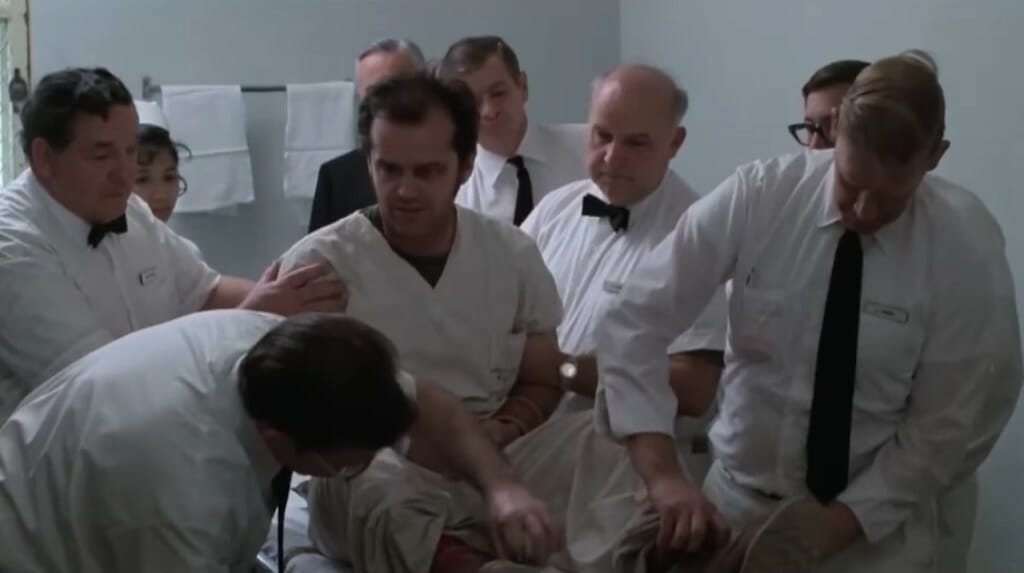The Legacy of the Anti-Psychiatry Movement
The push to end involuntary confinement four decades ago had unintended consequences that are being paid today by those forced to live with untreated mental illness. A scene from "One Flew Over the Cuckoo's Nest." (YouTube)
A scene from "One Flew Over the Cuckoo's Nest." (YouTube)
Last week marked 40 years since Franco Basaglia’s revolutionary work in Trieste, Italy, led to the groundbreaking Legge 180 (Law 180, also known as “Basaglia Law”), which ended the practice of involuntary confinement in asylums throughout Italy. The anti-psychiatry movement was part of a larger intellectual and professional movement promoted through the efforts of Basaglia, Michel Foucault in France, R. D. Laing in Great Britain, Thomas Szasz in the United States and Erving Goffman in Canada. These thinkers critiqued the legal powers conferred on psychiatrists to detain and treat individuals with mental health disorders, which contributed to the medicalization of madness.
They also championed the notion that personal subjectivity is independent from any hegemonic mandate of normalcy imposed by organized psychiatric medicine. This movement even suggested that mental illness might not exist at all outside of the language to frame the other. Basaglia’s work in the asylum in Trieste became a model for radical psychiatrists internationally who had been laboring in their own countries to end the forced institutionalization of patients and attempting to forge a new model of mental health care.
Part of the post-war anti-psychiatry movement, Basaglia’s political ethos was born from his six-month internment in Venice’s Santa Maria Maggiore prison for his participation in the Italian resistance. Basaglia and other prisoners escaped in April 1945, months before the end of the Second World War.
After receiving his medical degree in 1949 from the University of Padua, where he trained in the school of psychiatry, his experience as director of a provincial asylum in Gorizia (now located in Slovenia) would affect his political and philosophical ideas. In was at this point, early in his career, that Basaglia was pushed from Padua to Italy’s border regions for having been critical of the medical profession’s confinement model. In Gorizia, shocked by use of chains, straitjackets, bars and other modes of confinement, Basaglia sought to understand why an institution that was ostensibly about helping people seemed very much to punish them.
Inspired by Goffman’s “Asylums: Essays on the Social Situations of Mental Patients and Other Inmates” (1961) and Foucault’s “Madness and Civilization: A History of Madness in the Classical Age” (1961), Basaglia became a fierce critic of what he referred to as the “total institution,” which turned people into “non-persons” and produced a discourse of deviance in which individuals were excluded from and broken down by society.
Basaglia viewed “mental illness” not as a disease, but as an expression of human needs. From Gorizia, he took a director role of the asylum in Trieste, where he would stay until 1979. In Trieste, 90 percent of the 1,182 patients in the psychiatric hospital were nonvoluntary, living in conditions similar to those in Gorizia. It was here that Basaglia’s work would become a beacon of change—one that would finally end psychiatric institutionalization in many parts of the world.
Basaglia instituted open staff meetings and involved the local community in cultural events outside the institution’s walls. The hospital staff, together with the patient-turned-subject, staged cultural performances, joining forces with actors, musicians, repertory companies and artists from around the world.
Basaglia transformed the “total institution,” from one built on hard-and-fast rules in which medical violence was kept from public view into an open, creative space in which freedom and participation by those inside and outside its walls served as a model for the new “anti-asylum.” By creating cultural events inside and outside the hospital that included performances by the likes of Ornette Coleman, as well as airplane excursions and art exhibits, the contained space of “mental illness” was demystified and opened to an inclusive model of society.
As a result of Law 180, Basaglia’s work became the basis for radical psychiatric reform around Europe and beyond—even extending to New Zealand and Australia—with hundreds of institutions closing over the next decade. With each closing, the abuses of power within these hospitals became better known—as did the reasons for confining individuals to them.
Anna Marchitelli and Annacarla Valeriano have documented how the mental hospital was used to contain women who had merely broken out of roles imposed by the patriarchy and were deemed “mentally ill” for their refusal to get married, stay home or have children, as were women who were labeled “nymphomaniacs” or deemed loquacious, incoherent and exhibitionistic. They also note that asylums have been used to lock up artists, people suffering from social exclusion and medical debt, those whose political ideas were viewed as dangerous, and even to contain and “cure” homosexuals. Yet the long-term effect of the movement to deinstitutionalize the mentally ill has had harsh consequences in countries where the absence of solid social structures and services have ushered in the liberalization of the mental-health market.
The theoretical roots of the anti-psychiatry movement in the United States date to the late 1950s. Szasz, a psychiatrist and psychoanalyst, first criticized the legitimacy of “mental illness” as a legal term in an article he wrote in 1958 for the Columbia Law Review. At the time “Psychiatry, Ethics, and the Criminal Law” was published, only five states in the U.S. barred involuntary commitment of people with “mental illness.”
Drawing parallels between the practice of committing patients to mental hospitals and the prison system, Szasz maintained that psychiatrists were given the power to command a sentence of “insanity” and to indefinitely intern patients who are suffering, all the while treating them like criminals. Szasz kicked off the anti-psychiatry movement in North America while foreshadowing the privatization of mental health care in the future: “All ‘hospitals’ should function essentially as private medical institutions do at present.” In response to what he saw as a dangerous collaboration between the state and psychiatry, Szasz was instrumental in forming the Libertarian Party in 1971, whose primary platform called for the end of government collaborations with psychiatry.
Unlike in Italy, in the U.S., the deinstitutionalization of mental health care took place in phases. The first occurred just after 1963, when President John Kennedy signed the Community Mental Health Act, which encouraged the shift of mental health care from large institutions back to the community. Later, President Lyndon Johnson signed into law the Social Security Act Amendments of 1965, which created Medicaid, which would pay for the health care of low-income families. But this had a detrimental effect on people in mental health care institutions who were transferred into nursing homes.
The 1966 U.S. Court of Appeals case Lake v. Cameron established that psychiatric care should take place in the least restrictive setting possible, and the following year, California’s Gov. Ronald Reagan signed the Lanterman-Petris-Short Act. While this law ended the practice of institutionalization, it resulted, in the following year, in the twofold increase of the mentally ill in California’s criminal justice system.
Later administrations were more conscious of the need for community-based centers, with President Jimmy Carter signing the Mental Health Systems Act of 1980 to fund more community health centers. This still did not address chronic mental illness treatments. But this act was quickly repealed by President Reagan’s devastating Omnibus Budget Reconciliation Act of 1981, which moved funding to the state level through block grants. This forced mental health centers to compete with other public programs, including public housing, food banks and drug programs. As a result, mental health rarely received funds, and the 1980s was marked by an increase in homeless people who were mentally ill. This was particularly notable in metropolitan centers.
There were also some unlikely figures in the anti-psychiatry movement in the U.S. For instance, L. Ron Hubbard, the founder of Scientology, joined forces with Szasz in 1969 to create the Citizens Commission on Human Rights, a watchdog for psychiatric human rights. And between the publication of Ken Kesey’s “One Flew Over the Cuckoo’s Nest” in 1962 and the release of its film adaptation in 1975, public opinion the U.S. shifted radically against the asylum model.
The U.S. anti-psychiatry framework differed slightly from Italy’s in how the long-term changes eventually took effect. After the asylum model was abandoned in most states by the late 1970s, with a shift to community-based care, it was not until the Reagan administration that the larger deinstitutionalization movement came into force in 1981.
This move accounted for the scenario in which approximately one-third of all homeless people in the U.S. had severe mental health issues, which had repercussions for how mental health care would be accessed in the future. First, for those who can afford it, mental health care is accessible in the private market. Of the 300,000 inmates in the U.S. prison system diagnosed with mental health problems, 30,000 receive treatment in psychiatric facilities. The remaining prisoners, like many homeless people with mental health problems, are left without any support.
Starting in 2009, as a result of the Great Recession, states cut $4.35 billion in public mental-health spending over the next three years. This was the largest reduction in funding since deinstitutionalization began. Today, there are approximately 37,679 psychiatric beds in the United States, which is about 12 beds for every 100,000 people, a lower ratio than in 1850. With increasing numbers of mental-health patients in American jails, there is a serious problem in how deinstitutionalization has been abandoned and replaced by the private model—or left unexamined.
We must revisit the ideals of the anti-psychiatry movement in the U.S., because it is clear that deinstitutionalization simply moved the furniture around. This left other institutions to take over the role of mental health care, leaving the most vulnerable with no treatment and no community.
Your support is crucial...As we navigate an uncertain 2025, with a new administration questioning press freedoms, the risks are clear: our ability to report freely is under threat.
Your tax-deductible donation enables us to dig deeper, delivering fearless investigative reporting and analysis that exposes the reality beneath the headlines — without compromise.
Now is the time to take action. Stand with our courageous journalists. Donate today to protect a free press, uphold democracy and uncover the stories that need to be told.






You need to be a supporter to comment.
There are currently no responses to this article.
Be the first to respond.